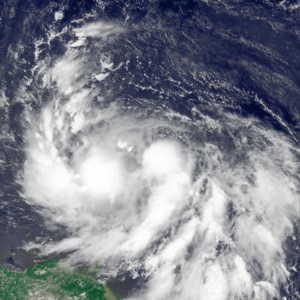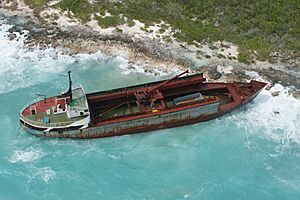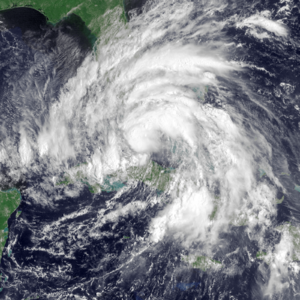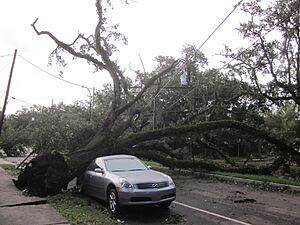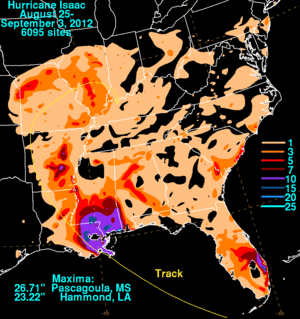Hurricane Isaac facts for kids
Tropical Storm Isaac was a powerful storm that started as a tropical wave off the coast of Africa in August 2012. It quickly grew stronger, first becoming Tropical Depression Nine-L, and then a tropical storm named Isaac. This storm traveled across the Caribbean Sea and the Gulf of Mexico, bringing heavy rain and strong winds to many areas.
Contents
How Isaac Formed and Grew
Isaac began as a tropical wave, which is like a ripple in the air, that moved off the coast of Africa on August 16, 2012. As it traveled west, it found warm ocean waters and favorable conditions, allowing it to organize and become stronger.
Becoming a Tropical Storm
By August 21, the system had developed enough to be called Tropical Depression Nine-L. Just a few hours later, it gained more strength and was officially named Tropical Storm Isaac. This meant its winds were getting faster, reaching speeds of at least 39 miles per hour (63 km/h).
Isaac's Path and Impact
Tropical Storm Isaac moved across the Caribbean, affecting several islands before heading towards the United States. It brought heavy rainfall and strong winds, causing flooding and damage in many places.
Impact on the Caribbean
Isaac first hit islands in the eastern Caribbean, including Guadeloupe and Haiti. In Haiti, which was still recovering from a major earthquake, the storm caused significant flooding and made conditions difficult for many people.
Damage in Puerto Rico
Even though Isaac didn't make a direct hit on Puerto Rico, it caused rough seas and strong winds. One notable event was a cargo ship, the MV Jireh, that became stranded on a beach on Mona Island due to the storm's powerful waves.
Approaching the United States
After moving through the Caribbean, Isaac entered the Gulf of Mexico. It continued to gain strength as it moved closer to the U.S. coast.
Landfall in Louisiana
Isaac eventually strengthened into a Category 1 hurricane before making landfall in Louisiana on August 28, 2012. It moved very slowly, which meant that areas experienced strong winds and heavy rain for a longer time.
Flooding and Power Outages
The slow movement of Hurricane Isaac caused widespread flooding, especially in coastal areas of Louisiana. Many homes and businesses were damaged, and hundreds of thousands of people lost electricity. While New Orleans experienced hurricane-force winds, its levee system, rebuilt after Hurricane Katrina, largely protected the city from major flooding.
Rainfall Totals
Isaac brought a lot of rain to the areas it passed over. Some places received more than 20 inches (500 mm) of rain, leading to significant flooding. The storm's heavy rainfall extended far inland as it weakened and moved across the central United States.
After the Storm
After making landfall, Isaac gradually weakened as it moved inland. It eventually became a tropical depression and then just a regular area of low pressure. However, its heavy rains continued to affect states like Arkansas, Missouri, and Illinois.
See also
 In Spanish: Huracán Isaac para niños
In Spanish: Huracán Isaac para niños


